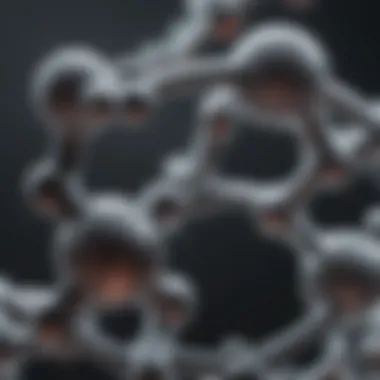Exploring the Solubility of Polyethylene Glycol


Intro
The solubility of polyethylene glycol (PEG) plays a crucial role in various fields, from pharmaceuticals to materials science. Understanding how PEG interacts with different solvents can improve applications significantly. To comprehensively explore this topic, it is essential to dissect how several factors impact its solubility. This examination will cover PEG’s molecular characteristics, measurement methodologies, and advances in research related to its solubility properties. Such insights will elucidate the practical implications of PEG's behavior in diverse settings.
Key Findings
Major Results
The investigation of PEG’s solubility reveals several important findings:
- PEG solubility varies significantly depending on solvent properties, especially polarity and temperature.
- Molecular weight of PEG affects its solubility; larger molecules tend to have reduced solubility in many solvents.
- The presence of additives or co-solvents can result in enhanced solubility.
- Specific interactions between PEG and solvents, such as hydrogen bonding and Van der Waals forces, directly influence solubility behavior.
These findings emphasize that understanding PEG's interaction with solvents is vital for optimizing its use in practical applications.
Discussion of Findings
The findings collectively indicate that PEG displays unique solubility characteristics, which can be tailored through careful selection of solvents and conditions. The solubility behavior observed can be predicted by theoretical models, which include concepts such as solvation theory and phase equilibrium. By analyzing how molecular size and environmental factors affect PEG's solubility, researchers can better predict how PEG will behave in real-world applications.
"The significant variation in solubility with different solvents underscores the importance of tailored formulations for specific applications."
Methodology
Research Design
The research on PEG's solubility begins with a structured research design that incorporates both experimental and theoretical approaches. Experimental methods involve direct measurement of solubility in various solvents under controlled conditions, while theoretical analyses utilize computational models to predict solubility trends based on molecular characteristics.
Data Collection Methods
To measure PEG's solubility effectively, several methods are employed:
- Solvent Mixture Techniques: Creating mixtures of solvents to study PEG solubility across different concentrations.
- Spectrophotometry: Using spectroscopic methods to quantify the concentration of dissolved PEG in solutions.
- Thermal Analysis: Analyzing phase changes in PEG as a function of temperature to assess its solubility limits.
These methods allow for comprehensive insights into the solubility properties of PEG, leading to enhancements in its applications within various fields.
Prelims to Polyethylene Glycol
Polyethylene glycol (PEG) serves as a versatile compound in a multitude of applications. From pharmaceuticals to industrial processes, understanding its properties is crucial for researchers and professionals alike. This section aims to lay the groundwork for further discussions on PEG's solubility by first establishing a solid introduction to the substance itself.
Overview of Polyethylene Glycol
Polyethylene glycol is a polyether compound with various molecular weights and forms. It is commonly utilized in different industries due to its soluble nature and biocompatibility. PEG is often used in pharmaceutical formulations, as it can enhance the solubility of drugs, thus impacting bioavailability and therapeutic efficacy. Moreover, its usage extends to cosmetics, food production, and manufacturing processes.
The broad applicability of PEG is attributed to its unique physical and chemical characteristics. In addition to its solubility, PEG possesses low toxicity and is readily excreted from the body, making it suitable for various medical applications. Understanding the solubility of PEG is essential for optimizing its utilization in these fields.
Chemical Structure and Properties
The chemical structure of polyethylene glycol comprises repeated units of ethylene oxide, forming a long-chain polymer. The basic formula of PEG is C2nn+2O)n, where 'n' represents the number of repeating ethylene glycol units. This structure allows PEG to exist in various forms, characterized by differing molecular weights, which significantly affect its properties and solubility.
PEG is highly hygroscopic, meaning it can absorb moisture from the environment. This property can be advantageous in creating stable formulations that require moisture retention. However, it can also pose challenges when aiming for precise solubility profiles in different solvents.
The solubility of PEG increases with lower molecular weight, making it more effective in dissolving various agents. As the molecular weight increases, the compound tends to be less soluble in water and other solvents. It is essential to consider these structural characteristics when evaluating PEG's performance in specific applications, particularly in drug delivery systems.


"Understanding PEG's solubility is pivotal for its effectiveness in enhancing the delivery of pharmaceuticals and ensuring proper formulation stability."
By contextualizing the significance of polyethylene glycol, this section sets the stage for a more detailed analysis of solubility behavior, influenced by molecular interactions and external factors.
Defining Solubility
Defining solubility is a crucial aspect of understanding the behavior and characteristics of polyethylene glycol (PEG) in various environments. Solubility refers to the ability of a substance to dissolve in a solvent, leading to a homogeneous solution. This concept is fundamental in many scientific domains, including pharmacology, materials science, and chemical engineering. Recognizing how solubility works can help determine how PEG is utilized in specific applications.
Basic Concepts of Solubility
The basic notion of solubility revolves around the interaction between solute and solvent. When a certain amount of solute, like PEG, is added to a solvent, the process of dissolving occurs through molecular interactions. These interactions include elements such as hydrogen bonding, van der Waals forces, and ionic interactions. Various factors affect how well a solute dissolves, such as temperature, pressure, and chemical structure.
A key principle to grasp is that solubility often depends on the nature of both the solute and the solvent.
- Polar solvents like water tend to dissolve polar solutes efficiently.
- Non-polar solvents, on the other hand, work better with non-polar solutes.
The phrase, "like dissolves like," summarizes this concept although it is not always comprehensive. Understanding these distinctions lays the groundwork for exploring the unique properties of PEG and its applications.
Factors Influencing Solubility
Several factors can significantly influence the solubility of PEG in different solvents. These include:
- Molecular Weight: PEG comes in various molecular weights. Lower molecular weights often result in higher solubility in water than higher weights due to increased steric hindrance and reduced intermolecular interactions.
- Temperature: Generally, increasing temperature enhances the solubility of solids in liquids. Therefore, knowing the temperature at which the PEG will be solubilized is vital for applications like drug delivery.
- pH and Ionic Strength: The pH level and the ionic strength of the solution can alter the solubility of PEG. Variations in ionic strength can affect the interactions of PEG with other solutes or solvents, which may cause changes in its solubility profiles.
- Presence of Cosolvents: Using cosolvents can modify solubility. For instance, mixing water with ethanol may enhance PEG’s ability to dissolve compared to water alone.
Understanding these factors is essential to optimize the use of PEG in practical applications, especially in pharmaceuticals where solubility directly impacts drug efficacy and delivery.
In summary, defining solubility provides a foundation for studying the solubility of PEG and its significance in various fields. By comprehending the basic concepts and factors influencing solubility, researchers can better leverage PEG's properties to develop innovative solutions in science and engineering.
Mechanisms of PEG Solubility
Understanding the mechanisms behind the solubility of polyethylene glycol (PEG) is crucial for various applications, especially in pharmaceuticals and material sciences. PEG's behavior in solution is dictated by its molecular structure and interactions with solvents. These mechanisms ultimately determine the efficacy and functionality of PEG in real-world applications, influencing factors like drug delivery and material properties.
Molecular Interactions in Solution
The dissolution of PEG in solvents relies heavily on its molecular interactions. PEG can engage in hydrogen bonding due to the presence of hydroxyl groups in its structure. This property enhances its solubility in polar solvents, such as water. In an aqueous environment, for instance, PEG molecules form hydrogen bonds with water molecules, allowing for compatibility and increased solubility.
Moreover, electrostatic interactions may also come into play, particularly when PEG interacts with charged particles. The extent of these interactions defines how well PEG fits within the solvent matrix — an essential consideration for its effectiveness in drug formulations.
Additionally, the steric effects of PEG, influenced by its molecular configuration, can affect solubility. Bulkier PEG molecules might face diffusion restrictions, impacting how they interact with solvents.
Role of Temperature and Concentration
Another significant factor affecting PEG solubility is temperature. As temperature increases, the solubility of PEG generally improves. Higher temperatures lead to increased kinetic energy within the solvent, which promotes the dispersion of PEG molecules. This elevates the rate at which PEG dissolves, enhancing its potential for various applications.
Concentration is equally important in understanding solubility mechanisms. At low concentrations, PEG can be easily dispersed in a solvent. However, at higher concentrations, self-association or aggregation can occur, which may hinder further dissolution. Recognizing the relationship between temperature and concentration allows researchers to optimize PEG formulations for specific industrial needs.
Effect of Molecular Weight on Solubility
Molecular weight is a defining characteristic of PEG that vastly influences its solubility. PEG exists in various molecular weights, and this variability directly correlates with its solubility behavior. Lower molecular weight PEGs tend to have higher solubility due to their smaller chain length, facilitating easier interaction with solvents.
In contrast, higher molecular weight PEGs may exhibit reduced solubility. This can be attributed to increased chain entanglements, which hinder efficient solvent penetration and interaction. Consequently, choosing the right molecular weight of PEG is vital when aiming for specific solubility and functionality in applications.
As these elements illustrate, a comprehensive grasp of the mechanisms underpinning PEG solubility enables better application in fields ranging from pharmaceuticals to industrial processing.


Experimental Methods for Measuring Solubility
Understanding solubility is critical in various fields, especially in pharmaceuticals and materials science. The methods used to measure solubility can greatly affect the interpretation and application of results in these fields. Accurate measurements lead to better formulations, ensuring the effectiveness of drugs and materials designed for specific functions.
Measuring solubility involves several techniques that allow researchers to determine how much polyethylene glycol (PEG) can dissolve in a solvent at given conditions. These methods are vital for assessing how PEG behaves in different environments, which directly impacts its application. The precise methods chosen depend on various factors such as the nature of the solvent, the molecular weight of PEG, and the desired concentration range.
Common Techniques for Solubility Assessment
Several methods are employed to assess PEG solubility in different solvents. Here are some of the common techniques:
- Visual Inspection: This basic method involves observing the dissolution process by eye. If the PEG dissolves completely, it confirms high solubility in that solvent.
- Filtration Method: This approach uses filtration to separate undissolved PEG from the solution. It permits the determination of solubility by measuring the remaining solid.
- Spectrophotometry: This technique provides quantifiable data by measuring the absorbance of light at specific wavelengths. It can be very effective for PEG solutions if there's a measurable change in absorbance as concentration increases.
- HPLC (High-Performance Liquid Chromatography): This advanced method is used to provide precise measurements of solubility. It separates mixtures and allows analysis at a very specific concentration.
Each technique has its pros and cons. For example, while visual inspection remains simple and quick, it lacks the precision of HPLC or spectrophotometry. Thus, the choice of technique can significantly impact the reliability of solubility data.
Analytical Methods in PEG Research
In-depth analytical methods are essential for understanding solubility behavior in research involving PEG. These methods help researchers gain insights into molecular interactions and solubilization processes. Key analytical methods include:
- NMR (Nuclear Magnetic Resonance): This method provides information on the molecular environment of PEG in solution, helping to identify interactions with the solvent.
- Dynamic Light Scattering (DLS): This technique assesses the size and distribution of PEG particles in solution, which can reveal how molecular weight affects solubility.
- FTIR (Fourier Transform Infrared Spectroscopy): This method is useful for studying chemical interactions at the molecular level, allowing researchers to see how PEG's structure changes in different solvents.
Overall, employing a combination of these methods yields a comprehensive understanding of PEG solubility. This multi-faceted approach is very valuable for students, researchers, and professionals who seek to explore or utilize PEG in their work.
"Selecting appropriate methods for measuring solubility is crucial. The effectiveness of PEG in applications heavily depends on the accuracy of these measurements."
By focusing on these experimental methods, researchers can move towards a more sophisticated understanding of PEG solubility, laying the groundwork for future innovations in its application.
Applications of PEG Solubility
The solubility of polyethylene glycol (PEG) plays a vital role in various fields. Understanding how PEG dissolves in different solvents can lead to meaningful advancements in pharmaceuticals and materials science. Applications of PEG solubility are diverse, with implications that affect drug delivery, formulation design, and even large-scale manufacturing. By exploring these applications, the discussion highlights critical benefits and considerations that arise from PEG's solubility features.
Pharmaceutical Applications of PEG
PEG serves a significant role in the pharmaceutical industry, particularly in drug formulation. Its solubility characteristics are crucial for enhancing the bioavailability of drugs. By incorporating PEG into drug formulations, it is possible to improve the solubility of otherwise poorly soluble therapeutic compounds. This enhancement can lead to better absorption in the gastrointestinal tract, ultimately resulting in more effective medicine.
Some specific applications of PEG in pharmaceuticals include:
- Solubilizing Agents: PEG is often used as a solubilizer for active pharmaceutical ingredients. Its capacity to create clear solutions makes it advantageous for intravenous medications.
- Controlled Release: PEG's ability to form hydrogels allows it to serve as a matrix for controlled drug release systems. This can be critical for achieving sustained therapeutic effects.
- Formulation of Excipients: Many excipients used in drugs are derived from PEG, helping to improve stability and extend shelf-life.
- Targeted Delivery: Modifying PEG can create targeted drug delivery systems, allowing medications to reach specific cells or tissues, enhancing the treatment's efficacy while minimizing side effects.
These applications illustrate how the solubility of PEG contributes to improving therapeutics. They also emphasize the need for ongoing research to explore the potential of PEG-based formulations.
Industrial Uses of PEG
Beyond pharmaceuticals, PEG's solubility properties have substantial implications in industrial applications as well. Its versatility is recognized across various fields, ranging from cosmetics to food processing and beyond. Understanding how PEG dissolves in different environments opens opportunities for innovation and efficiency improvements in manufacturing processes.
Key industrial applications of PEG include:
- Cosmetic Formulations: PEG is widely utilized in personal care products such as lotions, creams, and shampoos. Its solubility helps create smooth textures, enabling better skin absorption.
- Food Industry: In the food sector, PEG can act as a humectant, keeping products moist and extending their shelf life. Its solubility assists in mixing various ingredients effectively.
- Chemical Manufacturing: PEG serves as a solvent in synthesis routes, assisting in the production of polymers and surfactants. It facilitates reactions by enhancing the solubility of reactants.
- Surfactants and Emulsifiers: The solubility of PEG enables its use as a surfactant in emulsions, allowing for the stabilization of oil and water mixtures in various formulations.
Impact of PEG Solubility on Drug Delivery Systems
The solubility of polyethylene glycol (PEG) plays a crucial role in its application in drug delivery systems. Understanding how PEG dissolves in various solvents allows researchers and developers to optimize formulations for better efficacy. The unique properties of PEG, including its hydrophilicity and biocompatibility, enhance its function in drug delivery.


Enhanced Permeability and Bioavailability
One significant benefit of using PEG in drug formulations is its ability to enhance drug permeability and bioavailability. The solubility characteristics of PEG mean that it can help solubilize poorly soluble drugs. When PEG is part of a formulation, it facilitates the release of active pharmaceutical ingredients, allowing them to permeate biological barriers more effectively.
This enhancement is particularly important in oral drug delivery systems where achieving sufficient bioavailability is a challenge due to the gastrointestinal environment. The presence of PEG in a drug formulation can lead to:
- Improved dissolution rates.
- Increased absorption in the intestinal tract.
- Higher plasma concentrations of the therapeutic agent.
These factors lead to more effective therapies and can significantly enhance the therapeutic outcomes for patients. The interaction between PEG and the drug molecules often results in a more favorable pharmacokinetic profile.
Targeted Delivery Mechanisms
Another important aspect of PEG solubility is its role in targeted drug delivery mechanisms. Targeted drug delivery aims to maximize the therapeutic effect while minimizing side effects. PEG can be conjugated to drugs or nano-carriers, allowing for controlled release and targeted action in specific tissues or cells.
The effectiveness of this targeted approach is heavily influenced by:
- The solubility of PEG, which affects how well it integrates with other components in the system.
- The molecular weight of PEG, impacting the circulation time and distribution in the body.
Utilizing PEG not only aids in solubilizing the therapeutic agent but also enhances its targeting capabilities. This approach is particularly advantageous in the treatment of diseases such as cancer, where targeted delivery to tumor sites can significantly improve treatment efficacy and reduce systemic toxicity.
"The integration of PEG into drug delivery systems represents a turning point in enhancing therapeutic effectiveness and specificity."
In summary, understanding PEG's solubility is essential for improving drug delivery systems. The benefits of enhanced permeability, increased bioavailability, and targeted delivery are vital for pharmaceutical advancements.
Challenges in PEG Solubility Research
The research surrounding polyethylene glycol (PEG) solubility holds significant importance due to its extensive applications in various fields such as pharmaceuticals and materials science. Understanding the challenges in this domain facilitates not only the advancement of scientific knowledge but more importantly the development of effective technologies and delivery systems. This encompasses several complexities that affect how PEG behaves in solution. Addressing these challenges can unveil pathways to enhancing solubility profiles and optimizing practical applications.
Limitations of Current Knowledge
Despite significant progress in understanding PEG solubility, several limitations persist. One of the primary challenges is the complex nature of interactions between PEG and various solvents. There is a lack of comprehensive knowledge regarding the molecular mechanisms that underlie solubility.
- Variability in Molecular Weight: PEG has a variety of molecular weights, which contributes to inconsistent solubility behaviors. Different forms of PEG can exhibit dramatically different properties, complicating predictions about solubility in a given solvent.
- Lack of Standardized Measurement Techniques: There is an absence of universally accepted methods for measuring PEG solubility. This inconsistency leads to varied results across studies, making it difficult to compare findings.
- Limited Understanding of Conformational Changes: The conformational flexibility of PEG in solution is not well-defined, making it challenging to predict how it interacts with solvents at different concentrations and temperatures.
The consequences of these limitations can be significant when attempting to apply PEG in practical scenarios. For instance, a detailed understanding of its solubility could lead to improved drug formulations and delivery mechanisms.
Future Research Directions
Future research should aim to address current limitations and explore novel approaches to PEG solubility. Suggested directions include:
- Systematic Studies on Molecular Weight Effects: Investigating how different molecular weights of PEG interact with specific solvents can lead to better formulations in drug delivery systems.
- Establishment of Standardized Protocols: Creating standardized methods for solubility assessment would enhance the reliability of research findings across laboratories, fostering collaboration and progress in the field.
- Applications of Computational Modeling: Employing computational methods can offer deeper insights into molecular interactions and solubility. Computational models could predict solubility behaviors for various combinations of PEG and solvents.
- Focus on Environmental Factors: Research should also consider the influence of environmental factors such as temperature and pressure on PEG solubility, as these can significantly alter results in real-world applications.
By addressing these avenues, researchers can enhance the understanding of PEG's solubility and facilitate its use in industries reliant on solubility properties, ultimately improving both product efficacy and safety.
Finale
In this article, the exploration of polyethylene glycol (PEG) solubility culminates in a comprehensive understanding of its vital role in various scientific and industrial applications. This section puts emphasis on major insights gathered, establishes the importance of these findings, and considers future implications that arise from PEG solubility knowledge.
Summary of Key Findings
- Polyethylene glycol has versatile solubility characteristics that depend significantly on factors like molecular weight, temperature, and solvent types.
- The molecular interactions at play in PEG solutions highlight crucial mechanisms affecting its overall solubility.
- Various experimental methods elucidate how solubility is assessed, showcasing the advantages and limitations of each technique used in PEG research.
- The relevance of PEG solubility stretches across multiple domains, such as in pharmaceuticals and materials science, where it enhances permeability and bioavailability in drug delivery systems.
- Current research points to challenges that remain in fully grasping all aspects of PEG solubility, mandating ongoing inquiry and new methodologies.
Significance of PEG Solubility in Scientific Research
Understanding the solubility of PEG is not merely an academic exercise. The importance extends into practical application.
- Relevance in Drug Delivery: The solubility profiles of PEG influence the design of drug formulations, especially in areas requiring controlled release and targeting specific tissues. This makes it a subject of high interest for researchers focused on improving healthcare outcomes.
- Material Development: In materials science, PEG shows promise as a component in creating new materials exhibiting desired characteristics. Thes materials benefit from PEG's ability to dissolve in various solvents under different conditions, facilitating customization in product design.
- Future Prosperity: Continued examination of PEG solubility opens doors to innovations not just in existing applications but also in unexplored territories. Researchers are motivated to uncover new phenomena linked to solubility behavior that can lead to groundbreaking applications.
In summary, this article underscores that PEG solubility holds substantial significance for the scientific community. Understanding its roles and characteristics is essential for progress in multiple fields. Continuous research will enhance our grasp of PEG, which, in turn, promises to enrich its applications.



